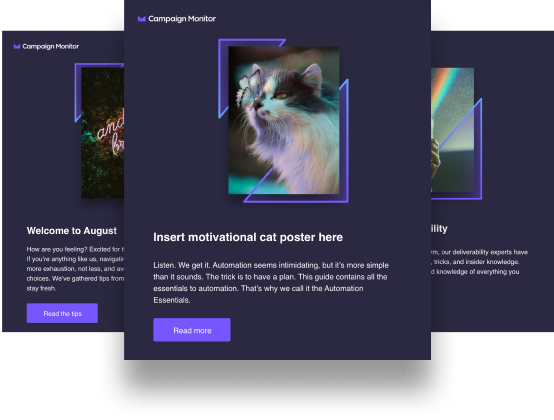The value of email marketing is undeniable. Time and time again, email proves to be one of the most effective marketing tools there is. But, since it’s been around for a while, not everyone is sold on needing it as part of a marketing strategy. Here’s how you can advocate for the value of email marketing and build a winning strategy.
It’s one of the most common pain points we hear from our customers.
I understand how great email marketing value is, but I haven’t been given the time or resources I need to do it right. How can I convince my boss/team/executives to make email more of a priority?
As with any strategy, the decision-makers in your company want to know what results they can expect before they’ll ever commit resources to it. Before stakeholders commit to any marketing strategy, they’ll want to know the potential business impact it might have.
And when you’re talking to someone who doesn’t actually work in email marketing on a daily basis, it can be tough to sell email marketing value. Since it’s been around for a long time relative to newer digital marketing mediums, it can feel like email is kind of, well, old school.
But we’re here to tell you that nothing could be further from the truth. In this post, we’re going to help you make the case — whether to a client if you’re in the agency world, or to internal stakeholders — for why you should invest in an email marketing strategy.
In today’s digital landscape, where social algorithms shift and ad policies evolve constantly, email marketing stands out as a resilient, dependable channel. Unlike social media, email is a direct line to your audience—there’s no intermediary deciding who sees your content. It’s a powerful tool for building authentic relationships that you control entirely, giving you access to your audience whenever you need it. Plus, email is permission-based, meaning your subscribers have actively opted in to hear from you, making it one of the most trusted forms of owned media. In an era where brands are racing to capture attention, email remains an essential foundation in any marketing strategy, allowing you to connect with your audience in ways that no algorithm can match.
Just how valuable are email marketing campaigns?
Email marketing is one of, if not the most profitable marketing channels out there, with a return on investment (ROI) ranging anywhere from 3600% to 4400%. That’s between $36-$44 for every $1 spent on email.
In case you’re not sure, that is incredible value! With returns like that, email needs to be included in anyone’s marketing efforts. And not just as a throw-in, but a serious area of focus.
While other mediums like social media can be important for awareness and engagement, they simply don’t drive revenue in the same way that email marketing does so reliably.
Small business owners and enterprise marketers can all benefit from the power of email. And, unlike some more advanced marketing tactics, getting started with email marketing (and even email marketing automation) is relatively easy.
Why is email marketing so much more effective than other mediums?
There are a handful of reasons why email marketing has such high conversion rates. Here’s are some of the benefits of email marketing over other channels.
Easy to personalize
Email gives you the ability to personalize your messages far more effectively than other mediums. Rather than blasting out the same message to every person, email gives you the ability to tailor your message.
Building audience segments and setting automation steps lets you send the right message, to the right audience, at the right time — making campaign optimization easy.
Reaches mobile devices
About half of all internet traffic comes from a mobile device. We know we don’t need to tell you this, but people are on their phones a lot in 2021, and email is the perfect way to reach them there.
About 85% of users use their smartphones to check email. Few marketing channels can be this certain to meet someone where you know they can be reached.
Integrates into your broader marketing plan
The versatility of email marketing is another thing that makes it such an attractive medium. You can run email to work in sync with other marketing tactics — like content marketing, SEO, PPC ads — to create cohesive campaigns.
Cost-effective
Compared to other marketing tactics like advertising, email marketing is very inexpensive. The only costs associated with email marketing are paying for an email service provider (ESP), and the labor that goes into creating your campaigns.
You can send as many emails as you’d like — like newsletters, welcome emails, transactional emails, customer retention emails, new product launches, follow-up emails, etc — and it won’t affect your bottom line.
Easily trackable
Relative to other mediums, it’s easy to monitor your email metrics and track results. Metrics like open rates*, click-through rates, and unsubscribes are all easy to find in your ESP’s reporting tool, making it easy to track results.
FAQs about starting an email marketing strategy (and how to answer them
We’ve heard a lot of feedback from you all about common questions or bits of pushback you’ve received around getting started with email. Here are the most common questions we’ve heard from you, and how to answer them to get your clients or stakeholders onboard.
“It’s just email — why should we spend more time and money on it?”
Sure, it is just email. But email is a much more powerful marketing tool than you might think.
The ROI of email marketing is at least double that of any other digital marketing channel. Plus, it’s one of the easiest places to reach your consumers where you already know they’ll be — their inboxes.
Not only is email one of the few marketing channels where consumers actually opt-in to hear from you, but people are also pretty much addicted to it. Think about it: How many times have you checked your email first thing in the morning? Last thing at night? In line at the grocery store or bank? In the waiting room at a doctor’s office?
Email reaches people everywhere. All the time. And that’s huge when it comes to communicating a message and producing big-time results.
“Can’t we get the same results from social?”
Inviting your brand into their inboxes is much more of a commitment from consumers than simply hitting “like” on a tweet. That’s a big part of why email marketing drives more conversions than any other channel. And the average purchase that comes from an email is more than three times higher than that of social media (McKinsey).
Despite these facts, we don’t like pitting email and social against one another. In an ideal scenario, they should work together to help you hit your goals (more on this in a sec). Features like social share buttons and live social feeds can help you draw more subscribers to your social channels, bringing more social followers to your email list.
“How do I know it’s email driving results as opposed to some other random factor?”
After you’ve sent a few campaigns, go ahead and dive into your data. You can draw direct correlations between an uptick in traffic and sales whenever you send. Or, if your email service provider integrates with your e-commerce platform, you can track the actual purchases that result from each email click.
But at the end of the day, email is just one part of the marketing mix.
Someone might get an email with an offer but choose not to act on it. Then, they could catch a social post or an ad from your brand that reminds them of your offer, causing them to visit your website directly. They may not have clicked on the email link, so the data doesn’t directly draw a correlation. But email certainly had a big part to play in the conversion journey.
“I get hundreds of emails every day that I don’t pay attention to. Why would I invest in that?”
That may be true, but we’d be willing to bet there’s a handful of brands whose emails you always pay attention to. That’s why it’s important to do email the right way — so your brand always sends relevant, personalized communications your email subscribers can’t wait to open.
Do you have some email marketing statistics to help me prove my case?
Do we ever. We won’t list all of the relevant email marketing statistics (because, honestly, there are too many to choose from), but here’s a list of relevant statistics to help you make the case for email marketing.
- There are over 4 billion daily active email users, more than social media platforms Facebook and Instagram combined (Statista). That covers pretty much every demographic.
- 90.3% of internet users in the US use email, compared to 69% of US adults on Facebook (Statista)
- Brands that always include an A/B test in their emails generate an ROI of 48:1 (Litmus)
- Marketers who use segmentation experience as much as a 760% increase in revenue (Campaign Monitor 😉)
- 4 out of 5 marketers said they’d rather give up social media than email marketing (Litmus)
- 91% of US adults like to receive promotional emails from companies they do business with (MarketingSherpa)
- Email is almost 40 times more effective than Facebook and Twitter combined in helping your business acquire new customers (McKinsey)
Wrap up
Email isn’t going anywhere. As marketing lives on and continues to develop in tandem with the modernized world, email marketing will only create new opportunities to engage with your audience.
And the best part: The more you use email to reach your audience, the more you’ll learn, and the better your emails will become. All this will only continue to show email marketing value to your organization and superiors.
And if you’re wondering what email marketing tools you should get started with, we’d love for you to check out Campaign Monitor. Our template library and approachable automation features make it easy to get your email marketing strategy up and running in no time.




